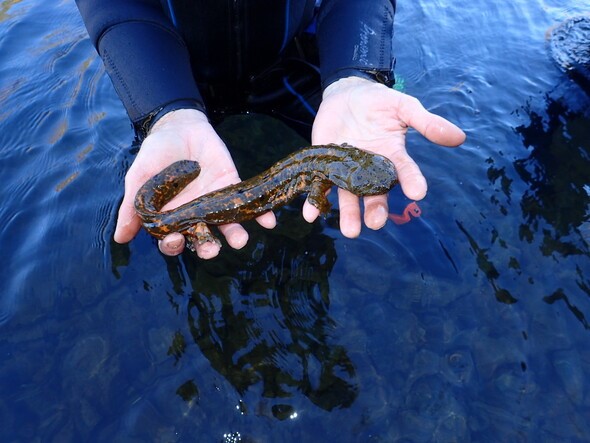The Hellbender (Cryptobranchus alleganiensis) is a large aquatic salamander native to North America, particularly found in the eastern United States. Known for its unique appearance and ecological significance, the Hellbender is an important indicator species for freshwater ecosystems. Here’s a detailed overview of this fascinating amphibian:
Key Features of Hellbender
1. Physical Appearance:
- Size: Hellbenders are one of the largest salamanders in North America, reaching lengths of up to 29 inches (74 cm), though they typically average between 18 to 26 inches (46 to 66 cm).
- Coloration: They have a distinctive brown or grayish body with dark mottling, providing excellent camouflage among rocks and submerged vegetation.
- Skin Texture: Their skin is soft and wrinkled, featuring numerous folds that increase the surface area for respiration, as they primarily breathe through their skin.
- Head and Limbs: Hellbenders have a broad, flat head with small eyes and a wide mouth. Their limbs are relatively small compared to their body size, and they have four toes on each front foot and five toes on each hind foot.
2. Habitat:
- Freshwater Ecosystems: Hellbenders inhabit clean, fast-flowing rivers and streams with rocky substrates, where they can hide and forage. They are often found under large rocks or in crevices in the riverbed.
- Temperature Preference: They prefer cooler water temperatures and are usually found in areas with high oxygen levels, which are essential for their respiration.
3. Life Cycle:
- Breeding: Breeding typically occurs in late summer to early fall. Males establish territories and attract females by creating nests under large rocks.
- Egg Laying: Females lay clusters of eggs (ranging from 100 to 500 eggs) in the nest, and males fertilize them externally.
- Parental Care: Males guard the eggs and may aerate them by fanning them with their bodies. The eggs hatch after about two to three weeks.
- Larval Stage: After hatching, the larvae remain in the nest for several weeks before dispersing. They grow rapidly and undergo metamorphosis, transitioning into adult Hellbenders over the course of several months to a few years.
4. Behavior:
- Nocturnal Activity: Hellbenders are primarily nocturnal, actively foraging for food at night.
- Territorial: Males can be territorial during the breeding season, defending their nesting sites from other males.
- Slow Movement: They are generally slow-moving creatures, using their large bodies to navigate the riverbed.
5. Diet:
- Carnivorous: Hellbenders are primarily carnivorous, feeding on a variety of prey, including:
- Aquatic insects (e.g., mayflies, caddisflies)
- Crayfish
- Small fish
- Other aquatic invertebrates
- Feeding Technique: They are ambush predators, relying on their camouflage to catch prey as it swims by.
6. Defense Mechanisms:
- Camouflage: Their mottled coloration allows them to blend into their rocky surroundings, making it difficult for predators to spot them.
- Slick Skin: Their slimy skin secretes mucus, which can deter some predators and protect them from infections.
7. Lifespan:
- Hellbenders can live up to 30 years or more in the wild, although many do not survive due to environmental pressures.
8. Conservation Status:
- IUCN Red List: Hellbenders are currently classified as Near Threatened or Vulnerable depending on the region, with declining populations observed in many areas.
- Threats:
- Habitat Loss: Deforestation, dam construction, and pollution have significantly impacted their habitats.
- Water Quality: Hellbenders are highly sensitive to changes in water quality, including sedimentation, chemical runoff, and temperature changes.
- Invasive Species: The introduction of non-native species, such as the Asian Carp, can disrupt the food chain and threaten local populations.
- Conservation Efforts: Various conservation programs aim to protect Hellbender habitats and promote water quality improvement. Efforts include habitat restoration, public education, and monitoring populations.
9. Adaptations:
- Aquatic Lifestyle: Hellbenders are fully adapted to an aquatic lifestyle, with streamlined bodies and strong limbs for navigating fast currents.
- Respiration: They primarily breathe through their skin, which allows them to absorb oxygen from the water while remaining submerged. Their gills are reduced in adults, reflecting their adaptation to life in clean, flowing water.
10. Interesting Facts:
- Cultural Significance: Hellbenders are often referred to as “snot otters” or “lasagna lizards” due to their appearance and slimy texture.
- Indicator Species: As an indicator species, the health of Hellbender populations can provide valuable insight into the overall health of freshwater ecosystems.
- Unique Reproductive Behavior: Their nesting behavior is relatively unique among salamanders, with males taking an active role in guarding and caring for the eggs.
- State Symbol: The Eastern Hellbender is designated as the state amphibian of Missouri.
11. Threats:
- Pollution: Agricultural runoff and industrial pollution can severely affect their sensitive habitats, leading to population declines.
- Climate Change: Changes in rainfall patterns and temperatures can alter water levels and quality, impacting Hellbender habitats.
- Human Encroachment: Urban development, damming of rivers, and increased recreational activities can disrupt their natural habitats.
- Aquatic insects (e.g., mayflies, caddisflies)
- Crayfish
- Small fish
- Other aquatic invertebrates
- Habitat Loss: Deforestation, dam construction, and pollution have significantly impacted their habitats.
- Water Quality: Hellbenders are highly sensitive to changes in water quality, including sedimentation, chemical runoff, and temperature changes.
- Invasive Species: The introduction of non-native species, such as the Asian Carp, can disrupt the food chain and threaten local populations.
The Hellbender is a remarkable amphibian that plays a crucial role in its ecosystem. Conservation efforts are essential to protect this species and its habitat, ensuring that future generations can appreciate these unique and ancient creatures.
